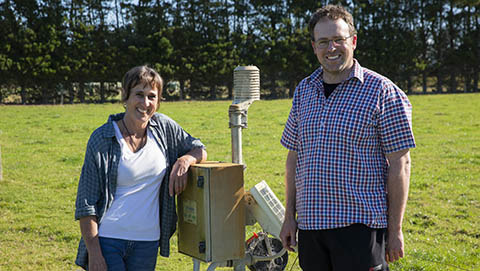Fernside dairy farmer Julie Bradshaw says sharing scientific data in a way that was easily understandable and useful for farmers helped create close bonds between landowners and NIWA scientists during a five-year joint co-innovation study.
Julie is participating in a six-month farming innovation project, which examines how the next generation of farmers are using innovative approaches to improve their farming practices. Waimakariri Landcare Trust (WLT) and Waimakariri Irrigation Limited (WIL) have partnered with the Ministry for Primary Industries (MPI) for the project, with support from MPI’s Sustainable Food and Fibre Futures fund along with Environment Canterbury, Ballance, and DairyNZ.
“It was a reciprocal relationship between our farmers and NIWA. They had no experience of dairy farming, but it worked because we were willing to listen to each other and NIWA had a genuine desire to provide us with data that was practical and helpful.”
Fellow co-innovation study group member Stu Bailey, a fourth generation Flaxton dairy farmer, says working with NIWA helped him to make better farming decisions, especially on irrigation.
“They developed an easy-to-use tool that helped us to do things better. Before the project we had limited data, but we now have a much broader understanding of what is really happening under the ground.
“In the past you would look at the top of the soil and think it looked too wet or too dry but actually it could be a bit dry on the top and wetter underneath where the grass roots are, and you wouldn’t know that unless you have the moisture probes to measure it.”
Stu says having access to a broad range of data has opened his eyes to how useful science can be when it is used in a practical way.
“We are looking at other ways to use the information and having the data helps us to feel confident that we are making scientifically based decisions. We have improved our irrigation infrastructure to better meet the demands of the soil and the grass which means we are now using less water.”
Julie would love to see further studies conducted to gauge the benefits gained during and after the project and she believes the project provides an excellent example for other groups who want to successfully engage with farmers to improve environmental outcomes.
“The difference with this project was that NIWA were responsive to our needs, and we worked together to understand what data would be most useful to help us meet environmental regulations and how best to receive this information.
“For example, in the beginning the moisture capacity of the soil was extremely basic and displayed in a percentage format and this was changed to a colour scale so we could see immediately where the moisture was sitting in the soil.
“We want information that is easy to understand in a couple of minutes because we are so busy working on the land that we don’t want to be sitting around reading long reports. We want to able understand what we need to do and then go out and do it.”
Meanwhile, this season Julie has been improving the condition of the grass on her farm. A consultant has conducted soil testing and provided insights into actions she could take to boost the nutrient value of the grass.
“We are looking at adding different species to our grass, along with plantains and a different mix of grasses to give us a wider spread.
“There is no point just adding more fertiliser if you don’t know where you sit – you have to consider the environmental impact of your actions.”
Julie’s KiwiCross herd which is a cross between Holstein-Friesian and Jersey cows is currently ranked in the top five percent of Canterbury herds for breeding and production and sits just outside the top five percent at a national level. She is passionate about continuing to improve the value of her herd through genetics.
“We have 99 per cent recorded ancestry and all our herd are DNA tested so we know exactly what we have and where we should be heading. As a business it is about getting the most efficient cows, and then breeding from those cows.
“All dairy farmers need to be taking action to have the best herd of cows because that is going to be the reality moving forward. Cow numbers are already being reduced across Europe to meet tougher environmental regulations and it will happen here too.
“The best thing to do is to start working towards your genetic metrics now, as it is not something you can do in a year. It will take at least five or six years to get the best herd and we need to be proactive about this.”

Fernside farmer Julie Bradshaw and Flaxton farmer Stu Bailey were able to make better informed decisions for their farms after participating in a five-year National Institute of Water and Atmosphere (NIWA) co-innovation study.